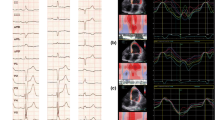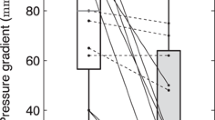Abstract
Cardiac failure is frequently complicated by intra and or interventricular conduction delay that results in dyssynchronized cardiac contraction and relaxation. In contrast to an electrical intervention by biventricular pacing, this study tests the capacity of geometric rebuilding by surgical ventricular restoration (SVR) to restore a more synchronous contractile pattern through mechanical reconstruction without exogenous pacing input.
Thirty patients (58 ± 8 years) undergoing SVR at the Cardiothoracic Center of Monaco were prospectively evaluated with a protocol which uses simultaneous measurements of ventricular volumes and pressure to construct pressure/volume (P/V) and pressure/length (P/L) loops. Mean QRS duration was within normal limits (100± 17 ms) preoperatively. Preoperative LV contraction was highly asynchronous. Endocardial time motion was either early or delayed at the end-systolic phase, yielding P/L loops with abnormal in size, shape, and orientation. Postoperatively, SVR resulted in leftward shifting of P/V loops and increased area; endocardial time motion and P/L loops almost normalized. The hemodynamic consequences of SVR included improved ejection fraction; reduced end-diastolic and end-systolic volume index; more rapid peak filling rate; peak ejection rate and mechanical efficiency resulting in mechanical intraventricular resynchronization that improves LV performance.
Similar content being viewed by others
References
Abraham WT, Fisher WG, Smith AL, Delurgio DB, Leon AR, Loh E, et al. Cardiac resynchronization in chronic heart failure. N Engl J Med 2002;346(24):1845–1853.
Bakker PF, Meijburg HW, de Vries JW, Mower MM, Thomas AC, Hull ML, et al. Biventricular pacing in end-stage heart failure improves functional capacity and left ventricular function. J Interv Card Electrophysiol 2000;4(2):395–404.
Cazeau S, Leclercq C, Lavergne T, Walker S, Varma C, Linde C, et al. Effects of multisite biventricular pacing in patients with heart failure and intraventricular conduction delay. N Engl J Med 2001;344(12):873–880.
Fauchier L, Marie O, Casset-Senon D, Babuty D, Cosnay P, Fauchier JP. Interventricular and intraventricular dyssynchrony in idiopathic dilated cardiomyopathy: A prognostic study with fourier phase analysis of radionuclide angioscintigraphy. J Am Coll Cardiol 2002;40(11):2022–2030.
Varma C, Sharma S, Firoozi S, McKenna WJ, Daubert JC. Atriobiventricular pacing improves exercise capacity in patients with heart failure and intraventricular conduction delay. J Am Coll Cardiol 2003;41(4):582–588.
Auricchio A, Stellbrink C, Sack S, Block M, Vogt J, Bakker P, et al. Long-term clinical effect of hemodynamically optimized cardiac resynchronization therapy in patients with heart failure and ventricular conduction delay. J Am Coll Cardiol 2002;39(12):2026–2033.
Chapman CB, Baker O, Reynolds J, Bonte FJ. Use of biplane cinefluorography for measurement of ventricular volume. Circulation 1958;18(6):1105–1117.
Sheehan FH, Bolson EL, Dodge HT, Mathey DG, Schofer J, Woo HW. Advantages and applications of the centerline method for characterizing regional ventricular function. Circulation 1986;74(2):293–305.
Baroni M, Barletta G. Digital curvature estimation for left ventricular shape analysis. Image Vision Comp 1992;10:485–494.
Weiss JL, Frederiksen JW, Weisfeldt ML. Hemodynamic determinants of the time-course of fall in canine left ventricular pressure. J Clin Invest 1976;58(3):751–760.
Di Donato M, Sabatier M, Dor V, Toso A, Maioli M, Fantini F. Akinetic versus dyskinetic postinfarction scar: Relation to surgical outcome in patients undergoing endoventricular circular patch plasty repair. J Am Coll Cardiol 1997;29(7):1569–1575.
Dor V, Sabatier M, Di Donato M, Maioli M, Toso A, Montiglio F. Late hemodynamic results after left ventricular patch repair associated with coronary grafting in patients with postinfarction akinetic or dyskinetic aneurysm of the left ventricle. J Thorac Cardiovasc Surg 1995;110(5):1291–1299.
Dor V, Sabatier M, Di Donato M, Montiglio F, Toso A, Maioli M. Efficacy of endoventricular patch plasty in large postinfarction akinetic scar and severe left ventricular dysfunction: Comparison with a series of large dyskinetic scars. J Thorac Cardiovasc Surg 1998;116(1):50–59.
Peschar M, de Swart H, Michels KJ, Reneman RS, Prinzen FW. Left ventricular septal and apex pacing for optimal pump function in canine hearts. J Am Coll Cardiol 2003;41(7):1218–1226.
Varma C, O’Callaghan P, Mahon NG, Hnatkova K, McKenna W, Camm AJ, et al. Effect of multisite pacing on ventricular coordination. Heart 2002;87(4):322–328.
Safwat A, Leone BJ, Norris RM, Foex P. Pressure-length loop area: Its components analyzed during graded myocardial ischemia. J Am Coll Cardiol 1991;17(3):790–796.
Theroux P, Franklin D, Ross J, Jr., Kemper WS. Regional myocardial function during acute coronary artery occlusion and its modification by pharmacologic agents in the dog. Circ Res 1974;35(6):896–908.
Tyberg JV, Forrester JS, Wyatt HL, Goldner SJ, Parmley WW, Swan HJ. An analysis of segmental ischemic dysfunction utilizing the pressure-length loop. Circulation 1974;49(4):748–754.
Sasayama S, Nonogi H, Fujita M, Sakurai T, Wakabayashi A, Kawai C, et al. Analysis of asynchronous wall motion by regional pressure-length loops in patients with coronary artery disease. J Am Coll Cardiol 1984;4(2):259–267.
Wiegner AW, Allen GJ, Bing OHL. Weak and strong myocardium in series: Implications for segmental dysfunction. Am J Physiol. 1978;235:H-776–H-783.
Di Donato M, Sabatier M, Toso A, Barletta G, Baroni M, Dor V, et al. Regional myocardial performance of non-ischaemic zones remote from anterior wall left ventricular aneurysm. Effects of aneurysmectomy. Eur Heart J 1995;16(9):1285–1292.
Athanasuleas CL, Buckberg GD, Allen BS, Beyersdorf F, Kirsh M. Controlled myocardial reperfusion after cardiac arrest saves the heart and brain. The Journal of the American College of Cardiology. In press.
Cafarella G, Maiello C, Romano G, Santarpino G, Tizzano F, Ursomando F, et al. Quality of life following ventricular restoration versus transplantation for extensive ischaemic cardiomyopathy. 2004.
Author information
Authors and Affiliations
Consortia
Corresponding author
Rights and permissions
About this article
Cite this article
Donato, M.D., Toso, A., Dor, V. et al. Mechanical Synchrony: Role of Surgical Ventricular Restoration in Correcting LV Dyssynchrony During Chamber Rebuilding. Heart Fail Rev 9, 307–315 (2005). https://doi.org/10.1007/s10741-005-6807-2
Issue Date:
DOI: https://doi.org/10.1007/s10741-005-6807-2




